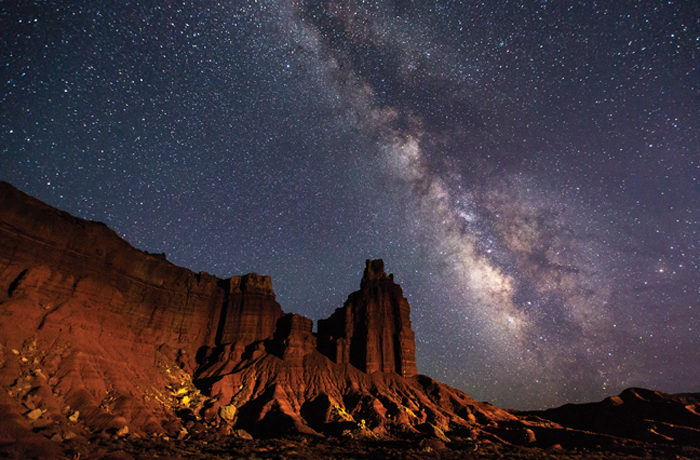Utah is home to 7 of the 42 world’s International Dark Sky Parks as well as Natural Bridges National Monument, the world’s first International Dark Sky Park, as certified by the International Dark-Sky Association (IDA). A Dark Sky Park is an area defined by the IDA where the night sky can be viewed clearly without any “light pollution.” These accolades position Utah as an ideal location for Astro tourists and avid stargazers to celebrate International Dark Sky Week, April 22-28, 2017.
Astro tourism is a rapidly growing tourism sector that encourages destinations to educate visitors and residents in areas with little to no light pollution on the wonders of the night sky. Because of its high number of International Dark Sky Parks and other low light areas, Southern Utah offers remote areas where visitors will find hundreds of square miles with no towns and few to no light bulbs. It is possible for visitors to find themselves in locations where 15,000 or more stars are visible in the night-sky. Astronomers believe that people who live in urban areas can see fewer than 500 stars and many have never seen the Milky Way.
During International Dark Sky Week 2017 and throughout the year, Astro tourists can visit Utahs’s Dark Sky Parks to experience a stargazing extravaganza. Six of the following Parks hold Gold Tier statuses because they offer outstanding quality night skies.
- Canyonlands National Park: During the spring and fall, Park rangers offer programming on a rotating basis with other Parks with the ultimate goal being to introduce visitors to the wonders of the night sky. Stargazing and telescope viewing follow ranger programming.
- Capitol Reef National Park: This Park has some of the best night sky viewing opportunities of the western national parks. Past summer stargazing programs have included Night Sky Tours by visiting astronomers.
- Dead Horse Point State Park: This Park has partnered with Canyonlands National Park to host dark-skies programming. It also best known for its use in the iconic final ‘Grand Canyon’ scene of the 1991 film Thelma & Louise.
- Goblin Valley State Park: The National Park Service’s Night Sky Team determined this park to have some of the darkest night skies on Earth offering it unparalleled views of the Milky Way. Visitors can experience a variety of ranger-led monthly moonlit hikes and telescope tours.
- Hovenweep National Monument: The Monument’s night sky remains about as dark as it was 800 years ago due to its geographic isolation. The Monument’s Rangers offer visitors stargazing programs throughout spring and summer.
- Natural Bridges National Monument: Gaze at the very same stars the ancestral Pueblo people observed 800 years ago. Park rangers will offer astronomy programs beginning May 2017.
- Weber County North Fork Park: Unlike the majority of International Dark Sky Parks, North Fork Park sets itself apart from the others because of its adjacency to urban areas and its innovative public art incorporating dark skies themes.
For additional information on travelling to Utah visit www.VisitUtah.com.
For further information or to obtain high res images please contact:
Joanne Motta, Media Relations Australia/NZ
C/- Canuckiwi GSA Utah Office of Tourism, Email: joanne@canuckiwi.com, Phone: +61 403 180 751
